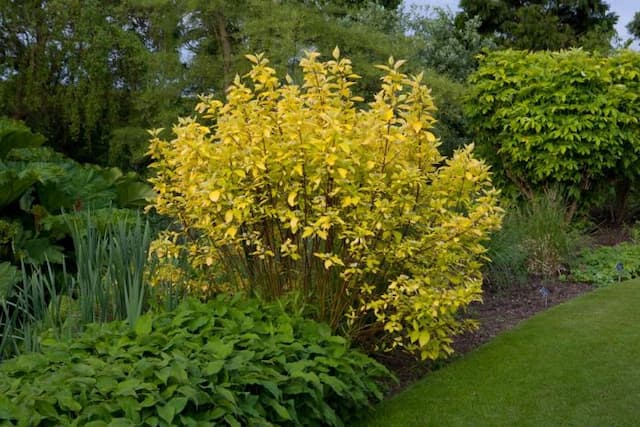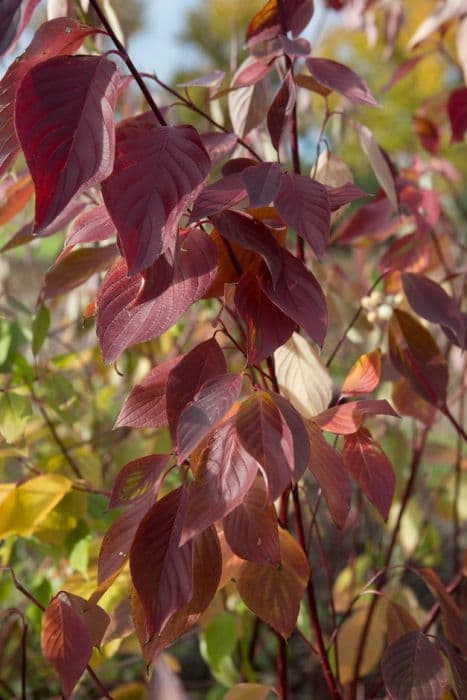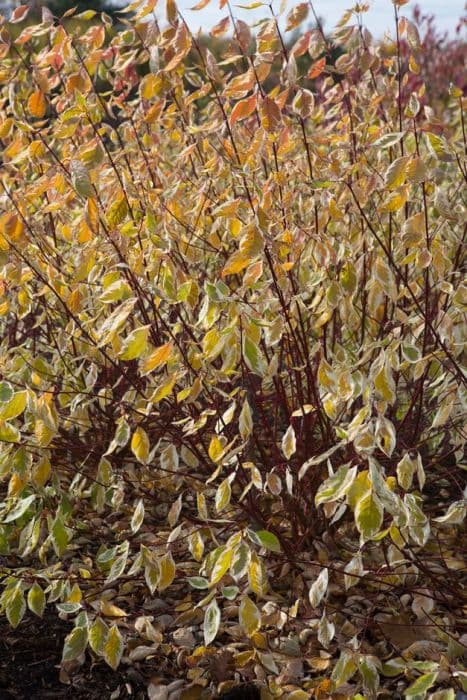Chinese Dogwood Cornus kousa var. chinensis 'White Dusted' (v)











ABOUT
The Chinese dogwood 'White Dusted' is a very attractive and ornamental plant. This variety is characterized by its showy, creamy-white flowers which have a distinct, somewhat dusty appearance that gives the cultivar its name. These flowers are not true flowers, but rather modified leaves called bracts, which surround the smaller, inconspicuous true flowers in the center. Typically, the bracts display a pointed shape and are arranged in a cross-like pattern. As the flowering season ends, the Chinese dogwood produces berry-like fruits which are a bright, eye-catching red. These fruits add a layer of visual interest to the plant and can attract birds to the garden. The foliage of this variety adds to its beauty. The leaves are dark green and oval-shaped with pointed ends, and they can demonstrate an attractive transitional color show. In the fall, the leaves often change to brilliant hues of red and purple, providing an impressive display of autumn color. The bark and structure of the Chinese dogwood 'White Dusted' are also noteworthy. The bark has a mottled, exfoliating texture that reveals patches of tan and gray, lending another layer of visual interest, especially during the winter months when the leaves have fallen. Overall, the Chinese dogwood 'White Dusted' is known for its distinctive floral display, attractive fall foliage, interesting fruit, and unique bark. These features combined make it a much-admired choice for landscaping purposes.
About this plant
 Names
NamesSynonyms
Chinese Dogwood, Kousa Dogwood, Korean Dogwood, Japanese Dogwood, Asian Dogwood.
Common names
Cornus kousa var. chinensis 'White Dusted' (v).
 Toxicity
ToxicityTo humans
The Kousa Dogwood is generally not considered toxic to humans. In fact, its fruit is sometimes consumed in small quantities in its native regions. There are no common reports of poisoning or toxic symptoms associated with the plant when touched or ingested.
To pets
Similarly, the Kousa Dogwood is not known to be toxic to pets. It is not listed as a toxic plant by the ASPCA and other animal safety organizations. Pets that ingest this plant typically do not exhibit symptoms of poisoning. However, consuming any non-food plant material might cause mild stomach upset in some animals.
 Characteristics
CharacteristicsLife cycle
Perennials
Foliage type
Deciduous
Color of leaves
Green
Flower color
White
Height
15-20 feet (4.5-6 meters)
Spread
15-20 feet (4.5-6 meters)
Plant type
Tree
Hardiness zones
5-8
Native area
Asia
Benefits
 General Benefits
General Benefits- Ornamental Value: The Kousa Dogwood ('White Dusted') offers significant ornamental value with its showy white bracts that resemble flowers in late spring and early summer.
- Four Season Interest: This variety provides visual interest across all seasons with spring and summer flowers, autumn colored leaves and berries, and an exfoliating bark in winter.
- Low Maintenance: Once established, it is relatively low maintenance, requiring minimal pruning and care.
- Drought Tolerance: Mature plants have good tolerance to drought conditions, making them suitable for landscapes with limited water availability.
- Attracts Wildlife: The red, berry-like fruits can attract birds and other wildlife to the garden, offering ecological benefits and natural pest control.
- Adaptability: Kousa Dogwood is adaptable to a variety of soil conditions and urban environments, making it a versatile choice for different landscape settings.
- Shade Production: The spreading canopy offers light to moderate shade, which can be beneficial for understory planting and creating comfortable outdoor spaces.
- Disease and Pest Resistance: This variety is resistant to many of the diseases and pests that commonly affect dogwoods, reducing the need for chemical treatments.
 Medical Properties
Medical PropertiesThis plant is not used for medical purposes.
 Air-purifying Qualities
Air-purifying QualitiesThis plant is not specifically known for air purifying qualities.
 Other Uses
Other Uses- Craft Material: The bark and branches of the Cornus kousa can be used in basketry and other woven crafts for their flexibility and texture.
- Wildlife Shelter: This plant offers nesting sites and shelter for various bird species within its dense foliage.
- Dye Production: The bark of the plant can be boiled down to produce a rich dye for fabric or other materials.
- Ink Making: Similar to dye, the bark and leaves of the Cornus kousa can be used to make natural inks for writing or artwork.
- Fish Poison: In some traditional practices, compounds from the plant were used to temporarily stun fish, making them easier to catch.
- Artistic Inspiration: The distinct shape and pattern of the flowers can be used as subjects or inspiration in paintings and drawings.
- Fruit Vinegar: The edible fruit can be fermented to make a unique, tangy vinegar used in culinary dishes.
- Landscape Design: Besides its aesthetic appeal, the plant can be used to create natural privacy screens or hedges in garden designs.
- Cultural Rituals: Certain cultures may use the parts of the plant for ceremonial or ritualistic purposes.
- Photography Prop: Because of its beautiful blooms, the plant is popular among photographers as a natural prop or background for outdoor portraits and macro photography.
Interesting Facts
 Feng Shui
Feng ShuiThe Kousa Dogwood is not used in Feng Shui practice.
 Zodiac Sign Compitability
Zodiac Sign CompitabilityThe Kousa Dogwood is not used in astrology practice.
 Plant Symbolism
Plant Symbolism- Protection: The Cornus kousa, commonly known as Kousa Dogwood, is traditionally viewed as a symbol of protection due to its hardy nature and strength.
- Purity: The white blooms of the Kousa Dogwood are often associated with purity and cleanliness, possibly because of their bright and unblemished appearance which stands out in the landscape.
- Endurance: As a tree that can withstand various environmental conditions, the Kousa Dogwood represents endurance and the ability to persevere through difficulties.
- Rebirth: The flowering of the Kousa Dogwood in the spring has made it a symbol of rebirth and new beginnings, signifying the end of the cold winter and the arrival of the warmer, life-giving seasons.
 Water
WaterKousa dogwood should be watered regularly, especially during its first growing season to establish a deep root system. After establishment, watering frequency can be reduced, but the plant will still benefit from additional water during dry periods. It is best to water deeply once a week, providing about 1 to 1.5 gallons of water each time. During hot, dry spells, increase watering to twice a week. Avoid overhead watering to prevent leaf diseases, instead apply water directly to the base of the plant.
 Light
LightKousa dogwood thrives in a spot with full sun to partial shade. The ideal location would receive morning sunlight and some afternoon shade, particularly in regions with hot summers. A spot that provides protection from harsh, afternoon sun will help prevent leaf scorch.
 Temperature
TemperatureKousa dogwood prefers moderate temperatures and will grow best when the temperature is between 60°F and 75°F. The plant is hardy and can handle temperatures as low as -10°F and as high as 85°F, although prolonged exposure outside of its ideal range may stress the plant.
 Pruning
PruningKousa dogwood may require pruning to maintain its shape and remove any damaged or diseased branches. Pruning should occur in late winter or early spring before new growth starts. Prune sparingly, focusing on dead or crossing branches to encourage healthy growth and air circulation. Occasional thinning may also be necessary to allow light to reach the inner branches.
 Cleaning
CleaningAs needed
 Soil
SoilChinese Dogwood 'White Dusted' thrives in acidic to neutral soil with a pH of 5.5 to 7.0. A mix of loamy soil, well-rotted compost, and a portion of sand or perlite for drainage optimizes growth. Mulching helps maintain moisture and soil temperature.
 Repotting
RepottingChinese Dogwood 'White Dusted' is a garden plant and generally doesn't require repotting. In landscapes, instead of repotting, periodic mulching and top-dressing the soil with compost are recommended.
 Humidity & Misting
Humidity & MistingChinese Dogwood 'White Dusted' prefers moderate humidity but is adaptable to various conditions. It does not require specific humidity levels, thriving in the natural outdoor humidity.
 Suitable locations
Suitable locationsIndoor
Provide bright, indirect light with ample space.
Outdoor
Plant in well-draining soil, partial sun/shade.
Hardiness zone
5-8 USDA
 Life cycle
Life cycleThe life cycle of the Cornus kousa var. chinensis 'White Dusted', commonly known as the Kousa dogwood, begins with seed germination, which occurs when soil temperatures and moisture levels become favorable in the spring. As the seedling emerges, it grows into a young plant with a basic root system and a set of leaves to start the process of photosynthesis. Over several years, the Kousa dogwood develops into a mature shrub or small tree, establishing a more extensive root system and woody stems, and it typically starts blooming in late spring to early summer, displaying its characteristic white-bracted flowers. After pollination, often by insects, the plant produces berry-like fruits that mature by late summer to fall, which are then dispersed by birds and other animals, allowing for the potential of new plants to grow elsewhere. During its mature stage, the Kousa dogwood undergoes annual cycles of growth, flowering, and fruiting. Eventually, as it reaches the end of its lifespan, which can be several decades, the plant's growth slows, and it may succumb to environmental stresses, diseases, or old age.
 Propogation
PropogationPropogation time
Spring-Early Summer
The Chinese dogwood, scientifically known as Cornus kousa var. chinensis 'White Dusted' (v), is most commonly propagated through semi-hardwood cuttings. This method is usually performed during the late summer when the new growth has matured enough to be slightly firm but still flexible. To propagate Chinese dogwood by cuttings, one would cut a 4-6 inch (10-15 centimeters) section of semi-hardwood, strip the leaves from the lower half, and possibly treat the cut end with a rooting hormone to encourage root development. The cutting is then planted in a well-draining soil mix, ensuring that the node where leaves were removed is buried, as this is where roots will typically emerge. The soil should be kept moist but not waterlogged, and the cuttings should be placed in an area with indirect light until they have rooted, which often takes several weeks.

![Dogwood [Baton Rouge]](/_next/image?url=https%3A%2F%2Fplants-admin.emdemapps.com%2Fimages%2Fplants%2F%2Fimages%2F604b59cf0fefd.png&w=640&q=75)


![Dogwood [Ivory Halo]](/_next/image?url=https%3A%2F%2Fplants-admin.emdemapps.com%2Fimages%2Fplants%2F%2Fimages%2F604b535cbcb9a.png&w=640&q=75)




